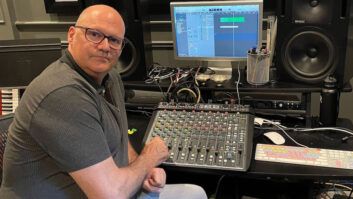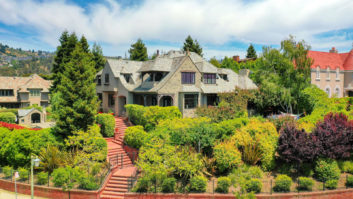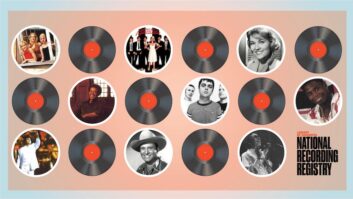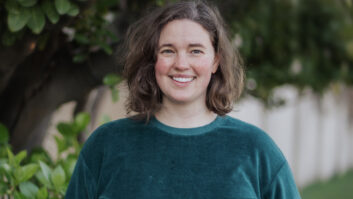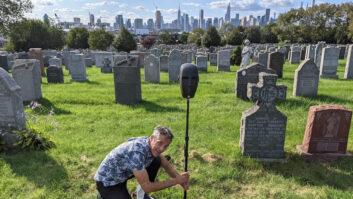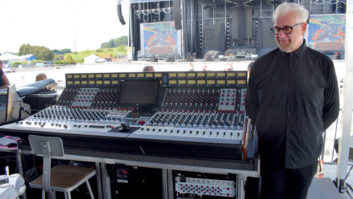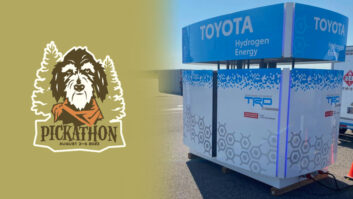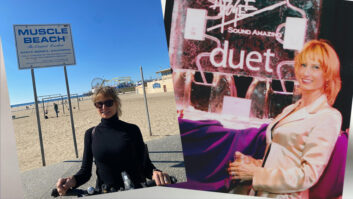STILL PUNK AFTER ALL THESE YEARSMothers don’t let your children grow up to be second engineers…The scene you hear at the opening of “Blood, Sex and Booze” from Green Day’s latest offering, Warning, is second engineer Tone getting a workout from dominatrix Mistress Simone. “I don’t know how much I should say about that,” says engineer Ken Allardyce with a laugh. “You can say there were a couple of dominatrixes in the studio. We needed a whip sound; that’s how it started.” Lo and behold, there was a mic hanging in the room. “This sort of went down incidentally. We found it afterwards and grabbed it.”
Really, would you expect anything different from the godfathers of neo-punk rock?
Warning, the band’s follow-up to the 1997 bestseller Nimrod, was recorded at Studio 880 in Oakland, Calif. The lads – guitarist/singer Billie Joe Armstrong, bassist Mike Dirnt and drummer Tre Cool – started writing songs for the album after the final Nimrod tour and rehearsed five days a week. The songs, explains Cool, “came together very organically throughout the time that we had off. They all came out of real experience. We went home and hung out with our friends and families for a while, then we got together a couple months later and started writing and practicing new songs.”
Engineer Allardyce reports the band’s comfort with the material enabled them to record efficiently. “They’d really done their homework, so they were nailing stuff really quickly,” he says. Last time, he explains, they recorded 30 songs. “So, it was way less focused when we did Nimrod. We just went in, recorded a bunch of songs and sorted out how it all fell together. On this one the guys pretty much had the album mapped out, blueprinted in its entirety.”
Before recording started, Allardyce and executive producer Rob Cavallo had their work cut out for them. Cavallo oversaw the installation of a new wood floor in the recording room, and Allardyce brought in an API console, as well as some Neve 1073s. “There was an SSL 4000 in there, but it wasn’t something I wanted to record through,” says Allardyce. “I’m not a fan of the older SSLs; we used it to monitor through, but not to record through.”
While Nimrod was recorded to tape, the Warning sessions were tracked right into Pro Tools. “I suppose they just wanted to stay abreast of technology,” explains Allardyce of the band’s choice. “It was the ease of everything, and we tried to speed things along. I’m not convinced that it’s quicker, really; in the long run, you get more options that you can play around with it more.”
Still, even with all the options Pro Tools presents, “it was incredibly fast,” he says, “to the point that we were getting three [drum] tracks a day. That’s pretty quick for these guys; certainly with Nimrod we would spend a day per drum track. On this record we just blew through them within a week.”
Cool’s kit remained consistent, with snares, cymbals and drum tuning being changed only sporadically. Allardyce turned to many of the usual suspects when it came to drum kit microphones: The bass drum got an AKG D-112 and Neumann U47 FET, the snare had a Shure 57 on top and a Sony C-55P on the bottom, and the toms were recorded via AKG C-12As. There was a C-55P on the hi-hat and an AKG 414 on the ride cymbal. Occasionally, Allardyce threw a Neumann KM84 on the hat, too. He used Telefunken 251s as overheads; room mics included 251s on a close room, Neumann M50s farther away, and one M149. They also used a Neumann U87 and several Shure SM57s for cool tones that were compressed room reflections.
Bassist Mike Dirnt had a setup that included three different Mesa/Boogie cabinets – a 4×10, a 2×15 and one with four 10s and a 15, each with its own tone. “Between those three, you could get from a real rich bottom end, to midrange, to click-y, kind of attack-y, bright things,” Allardyce explains. “So, basically we had all three running at the same time, and you could do a blend of what you wanted out of it. That was a bit of departure, but I’m really pleased with how that came out.”
Armstrong’s guitars also received careful attention, especially considering he was playing more acoustic guitars than ever before. “We changed guitars a lot; we played probably 10 different guitars,” Allardyce says. “The different colors come from the different guitars. We had a couple of 4×12 Marshall cabinets; on one we put a Marshall through it, and through the other we put a Fender Bassman. The basic Marshall, Fender Bassman was the sound each time.” The acoustic guitars were either miked with a pair of 251s or went through a direct box or miked at an amp.
As for the vocal tracks, Armstrong is an interesting study because he prefers to sing his vocals alone in the control room. No engineer, no bandmates – just him, a pair of headphones and a controller. It’s a formula he and Allardyce uncovered during the recording of Nimrod. “I’ve done it both ways with him,” Allardyce explains. “He’s sung with me just sort of being there and working with him, and it gets done, but on Nimrod we hit upon this method of doing it by himself. This time I suggested it to him again. At first he said he didn’t know, then I said, `Let’s try it, I know it works well with you.’ He tried it and said it was the most comfortable for him.”
Allardyce used a Sony prototype microphone run through a Neve 1073 and a dbx 160. “He’ll bang off a few takes and then we sit down together and comp it,” he explains. “Again, he did it really quickly. He didn’t have his voice strong enough to do one song after the other, but we’d do one a day.”
Cool explains the recording dates simply: “We record what we sound like; we don’t try to put it into a computer and change what we sound like. We’re actually good musicians who can play and we’re good singers, so there’s no need for any of that tricky business, you know. We’re just trying to get as many good sounds as we can.”
And rather than turning to an outside producer – Rob Cavallo had produced the band’s previous offerings and served as the executive producer for Warning – the band opted to produce themselves. “We know how to make records and we know what we want to get out of it,” says Cool. “We don’t really want to put it through another translator or filter the process. We want to make it a genuine statement from us, as far as even recording it at home in Oakland. It’s just a true statement of where we are in our lives.”
Allardyce says he kept his use of Pro Tools very simple on the project. “To be honest, with a band like Green Day I wouldn’t want to take the approach of using Pro Tools to do a lot of what it’s capable of, because that’s a little self-defeating in their case,” he says. “Basically they’re a live band who play, so if we started to get too tricky – the temptation is always there, of course – but I figured it would homogenize their trip too much. It would take a bit of the rawness out of them, if we started to get too tricky with the Pro Tools. So, we stayed clear of that.”
Cool adds, “If you go pristine in recording, you’re going to sound like Sting, and over-thought and over-clear, too sweet. We get good sounds that represent our attitudes and where we’re coming from. If they’re dirty, if they’re buzzy, but we like it, that’s what we like. Yeah, in some cases the pristine is called for, so there it is. In some cases we want a transitory sound on something, or more pushed.”
While most of the songs on the disc are fairly straightforward in their arrangements, a few stretched the band in ways they never have been before. One track in particular, “Misery,” has layers upon layers of different styles grafted into one rather messy whole. “Yeah, bloody hell, that is covered in shit,” Allardyce says. “That was a tough one in that it’s got so much different stuff on it. I think what we did was put a bunch of stuff on it and it was kind of selected in the mix a little more, because there was such a wide range of instrumentation on it and a whole bunch of styles as well.”
“We got David Campbell to do strings, we had a Mariachi band, [keyboardist] Benmont Tench and an Italian band,” Cool says. “We knew when we designed it that we were going to have a ton of stuff on it, but it’s interesting to put it on and hear it back. That was 80 tracks.” And that’s where the calm and collected mixer Jack Joseph Puig came into the fold. “It’s funny – Jack Joseph loves that shit. He doesn’t even trip.”
Puig comments that mixing the album at his room at Ocean Way Studios in L.A. (see the October 2000 cover of Mix) was an exciting time. “It’s an album full of really great songs, without a doubt,” he says. “They’re an amazing band, they play really well together. They’re great record makers, actually. They produced this one themselves, so they were very involved in it, they were very hands-on, and very in-there, and gave great input.
“Some albums have a lot of variety emotionally,” he continues, “and some start off one way and that’s what they are and that’s fine. This album has quite a bit of variety to it.”
Looking back now, Cool is proud of the album and explains that the band is not reacting to any style of fashionable music today. “That doesn’t affect us at all, man,” he says. “We’re not the kind of band that goes around jumping on bandwagons, as you can tell from our catalog. We’re more like the people who start it. That’s where we’re at now – we’ve got a new batch of shit for bands to copy. You won’t find any Limp Bizkit or Korn in my record collection; you might find it in my refrigerator. We’re an incredibly successful band, we don’t have anything to prove. We just want to make music to make ourselves happy and sound good.”
